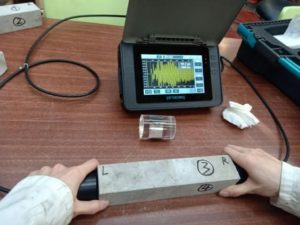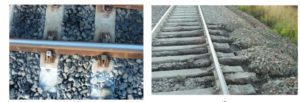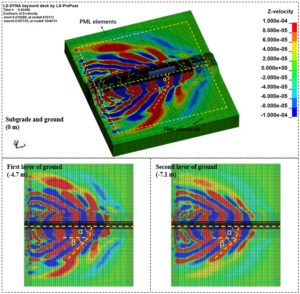Decarbonisation is not just about electrifying the network. The railway infrastructure is a significant proportion of rail’s carbon footprint and provides us with rich pickings for improvements including choice of:
- lower-Carbon materials and designs;
- managing assets more effectively;
- using AI and data science to underpin decision-making;
- applying whole-systems-thinking to the railway.
Here are some of the themes which Dr Sak Kaewunruen and Dr Michael Burrow are working on with their research groups:
Sustainable smart materials
Sak has been looking at eco-friendly construction and railway materials that enhance cleaner and lower carbon infrastructure; low-carbon materials including high-damping and self-healing concrete, 3D printing composites; and self-sensing materials that can monitor cracks and damage.

They have also looked at vibro-acoustic issues: problems that vibration cause include movement of ballast away from the sleeper, causing problems with the load-bearing capacity of the track. Using advanced simulations, AI and data science, they have built up a clearer understanding of how this happens and how to prevent or mitigate against it.

Lifecycle performance and forensics
Here is where our academics are looking at how we manage infrastructure throughout its lifecycle: from design, construction, operation, maintenance and ultimately to its disposal – the ultimate in sustainability. The researchers are looking at the many ways we can take Carbon out of infrastructure and assets and better-manage these assets so we can strike the balance between effective economics, social needs and ecological benefits. Together with Dr Gurmel Ghataora, Dr Michael Burrow has looked at enhancing drainage in ballasted and non-ballasted track, improving track foundations using in-situ remediation techniques; and he has developed a risk-informed decision-making tool for the economic appraisal of railway infrastructure investment decisions. And Sak has been instrumental establishing a new ISO Standard for recycling of rolling stock so results are already being seen.
Infrastructure engineering, resilience, reliability and risk
Under this theme our researchers are analysing and quantifying design reliability and uncertainty, taking into account safety, risk and uncertainty. This in turn allows engineers to design, construct and maintain infrastructure for operational readiness and resilience in uncertain settings. To come up with their innovative solutions to extreme events and uncertain demands, the team combines theory with practice: structural mechanics and principles of dynamics with field measurements and laboratory experiments, in order to determine robustness, vulnerability and resilience of materials, components and structures.
The researchers’ findings enhance service life of infrastructure, reduce waste and minimise whole-life cost, energy, and carbon footprint. They’ve also been used for the development of two new ISO/BSI Standards for railway concrete sleepers and for railway plastic sleepers and help railway operators respond to disruptions, structural failures and derailment risks. Another recent project looked at the interactions between the train, track and soil while a train passes to see where the forces are highest and therefore where maintenance efforts can be focussed.

In other projects we have collaborated with infrastructure managers and companies around the world to develop and deploy innovative and intelligent systems. These projects include optimising total track inspections during disruptions, managing risks and safety at railway stations, benchmarking resilience, operations and sustainability, and enabling adaptive maintenance of rail infrastructure systems. These multi-agent-based activities aim to build much more efficient and effective infrastructure systems, significantly reducing lifecycle cost, energy, and carbon footprint.
Pulling it all together with systems-thinking
In addition to technical speciality research themes, we make sure that the complex socio-technical context and a systems-thinking approach are taken into account fully for infrastructure decarbonisation. This will guarantee that externalities and social values are integrated at every stage of life cycle in the sustainable development of critical railway infrastructure.
Read more online at www.birmingham.ac.uk/railway and contact Dr Sak Kaewunruen and Dr Michael Burrow directly.
